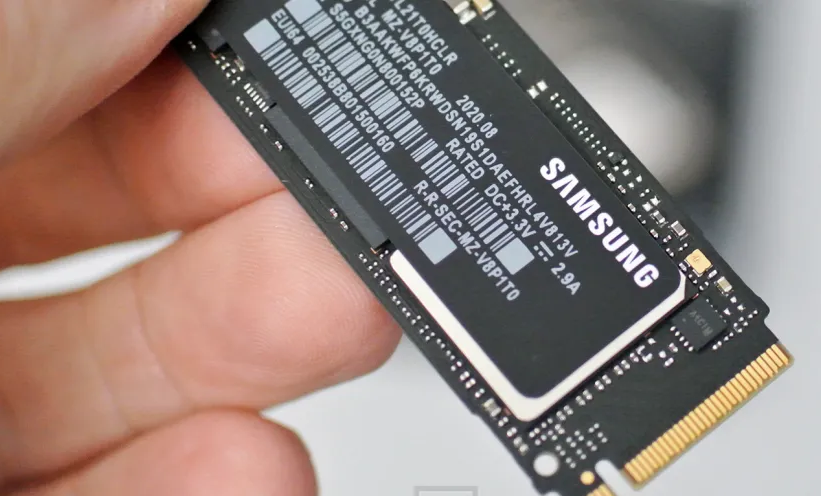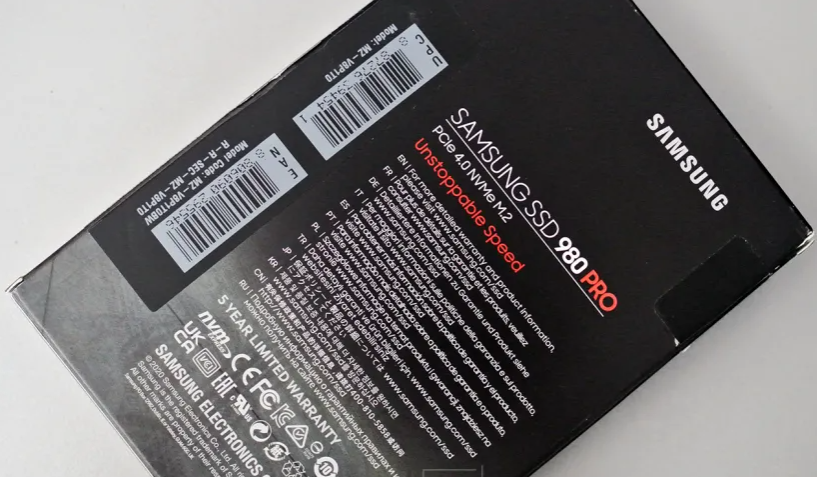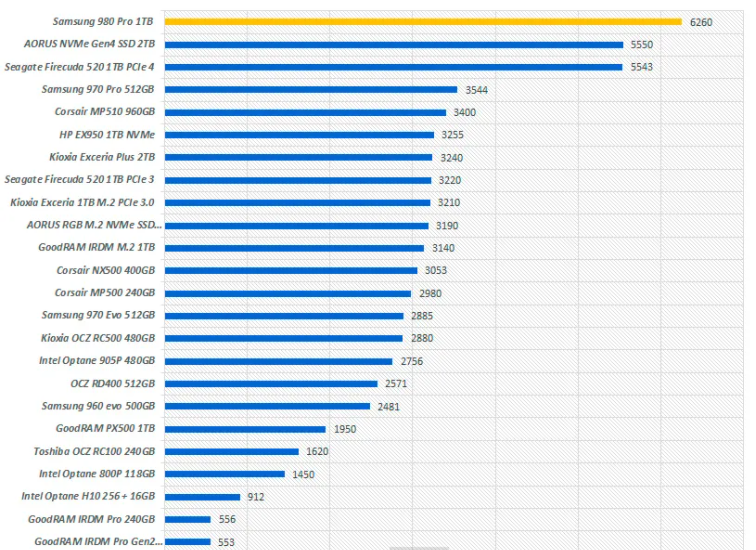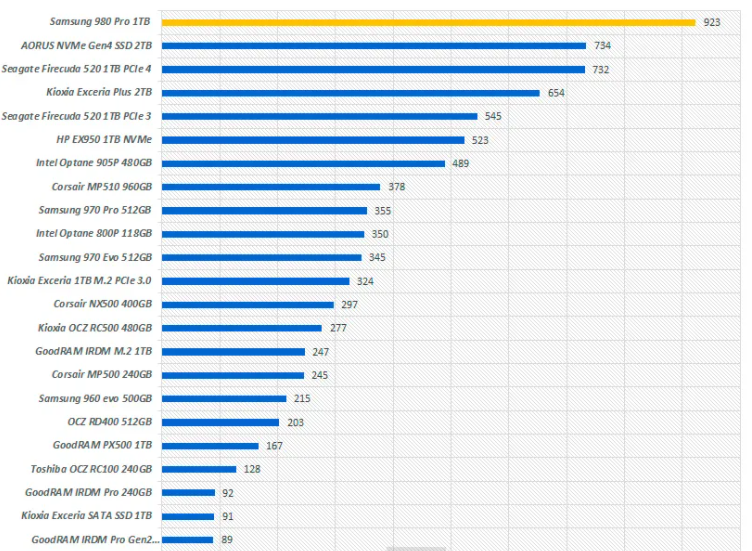Introduction to Samsung 980 Pro 1TB Features
Samsung did not seem to care much that AMD introduced new access capabilities in its latest generations of processors, allowing doubling the bandwidth in M.2 type drives thanks to the incorporation of the PCI Express 4.0 interface in a standardized way and directly supported by its processors.
It took months to react and to launch new generation units with this supported interface and with the appropriate controllers to get the full potential of this new interface. This has meant that for some time Samsung was not the brand that would lead the way in terms of performance, but now with the Samsung 980 Pro the market returns to its usual routine of recent years, as you can see in this review.
Technical characteristics of the Samsung 980 Pro 1TB
- Interface: PCIe 4.0 × 4, NVMe 1.3c
- NAND Flash memory: Samsung TLC 3D-VNAND 6th gen
- Size: M.2 2280-D2
- Controller: Samsung Elpis
- DRAM: Samsung 1GB LPDDR4
- Sequential Read (max, MB / s), 128KB: 7000
- Sequential Write (maximum, MB / s), 128KB: 5000
- Random Read (Max, IOPS), 4KB QD32 T8: 1,000,000
- Random Write (Max, IOPS), 4KB QD32 T8: 1,000,000
- Total Bytes Written (TB): 600
- Mean time between failures: 1.5 million hours
- Limited warranty (years): 5 years
- Power consumption in operation, average (W): 6.2 (7.9 maximum)
- Idle power consumption on PS3, average (mW): 35
- Low current consumption mode L1.2 (mW): 5
- Internal operating temperature (° C): 0 to 85
First Samsung PCI Express 4.0 drive with Elpis controller
The 1TB
Samsung 980 Pro is a unit that has been on the market since September last year and at that time it paved the way for second-generation SSD drives, a path that we have now seen as other manufacturers, who were ahead of Samsung in their Right now, they're trying to stick with drives that dramatically increase processing power and sustained read and write speeds.
These units are already beginning to approach the theoretical maximum that the PCI Express 4.0 interface is capable of producing, which is 8GBps of real transfer thanks to four PCI Express 4.0 links that produces up to 64Gbps of bandwidth, twice that of the interface units. PCI Express 3.0 with the same physical Socket3 M.2 configuration format for PCI Express with NVMe 1.3c support.
To feed the capabilities of a storage unit like this requires a controller capable of developing all this potential and handling many memory cells in parallel, it is the only way to achieve these sequential speeds and input and output processing.
Samsung has developed this new controller, under the Greek name Elpis, from the ground up and endowed it with the right capabilities to achieve its fastest drive to date and a benchmark for drives that have now started to arrive in the form of direct competition. in models such as the later Corsair MP600s or the new Gigabyte units with a second generation Phison PCI Express 4.0 controller.
This controller is capable of handling up to 128 input and output data queues simultaneously, which is up to four times more capacity than Samsung's old generation for its best PCI Express 3.0 drives. Each thread is made up of up to 64,000 sets of commands, so this controller is capable of executing up to 8 million commands simultaneously. To handle this processing power, Samsung has opted for an 8nm manufacturing process, developed by themselves.

This controller introduces new technologies, such as the second generation Intelligent TurboWrite, which provides a buffer up to five times higher than the previous generation. 6GB is used permanently for this technology, but it can be dynamically increased to a total of 114GB. It doubles the speed of previous generations of Samsung, including the mighty Samsung 970 Pro . This technology, like the previous one, requires enough free space on the drive to act, 324GB free in this 1TB model that we tested today, but it does not affect the durability of the drive since the number of writes remains the same.
Samsung accompanies these units with 1GB cache DRAM memory, in this unit, 2GB in the 2TB model and up to 512MB in the most basic 256 and 512GB models. This memory helps the unit to save the write addresses, which maximizes the performance of the unit regardless of the operating system we are using.
Sixth generation TLC VNAND 3D memories
For its Pro model Samsung has used TLC memories, somewhat better than QLC, which is defined by its 3bit per cell writing capacity. They are sixth-generation memories, which were introduced in 2019 and have been mounted in consumer-grade storage units from Samsung for some time. They are memories that support up to 136 layers (128 in the case of this unit in tune with the parallel processing capacity of the Elpis controller) and are adequate, price and durability, for a configuration like the one offered by the
Samsung 980 Pro .

Something we really like about this unit is that all memory configurations, up to 2TB at present, are achieved with a simple face configuration which means that it can be adapted to all types of systems since it does not require enough height to leave space for chips mounted on both sides. It is also more efficient when cooling and can be mounted in very compact systems, such as ultra-thin laptops.

The memories used, in TLC configuration, despite being far from the durability that MLC or SLC type memories would offer, combined with Samsung's error correction technologies, allow a minimum write durability of 150TB for the 256GB model, durability is directly proportional to size so for this unit of analysis we would have a total of 600TB of writing capacity with 0.3 of this capacity written per day. The official warranty is 5 years.
Samsung 980 Pro 1TB technical specifications
The second generation of PCI Express 4.0 storage drives started directly with this drive from Samsung. For months it has shone alone thanks to its state-of-the-art controller and the use of quality memories in parallel without forgetting that a storage unit of this type must be able to be mounted in any system on the market.
The format of the unit is standard, with 80mm long and 22mm wide, on a single side and with compatibility for mounting on any computer, whether or not it supports PCI Express 4.0. Of course, if we want to see it develop its full potential, we will have to mount it on an AMD Ryzen computer, either desktop or laptop. Intel, at least for the moment, does not have any commercial solution compatible with this interface, when it does, the
Samsung 980 Pro will be perfectly compatible.
Among the most noteworthy technical data of this model we find its sequential processing capacity of up to 7000MBps in reading and up to 5000MBps in writing . Random processing power reaches 1 million instructions per second, with a minimum of 60,000 IOPs in random write and up to 22,000 IOPs in random read.
The consumptions are also interesting because thanks to the use of state-of-the-art memories and a controller with a very modern manufacturing process, the consumptions remain in those of the previous generation with 6.2w of average consumption in load and less than 35mW in standby with consumption less than 5mW in full sleep states.
We can manage the operation of the unit, including firmware updates through the Samsung Magician application that many of you will already use in Samsung units of other generations. This application allows monitoring, performance analysis, internal software updates, etc.
Samsung 980 Pro 1TB temperatures
Load temperature, without heatsink
Idle temperature, with heatsink
Load temperature, with heatsink
The drive that has led the way to the second generation PCI Express 4.0.
On the one hand, we already expected the results obtained, far above any other unit that we have tested, but it is also nice to see how this unit sweeps away the competition, at least those of the first generation, which we have also tested with an interface PCI Express 4.0.
Atto Sequential Read
Atto Sequential Write
AS-SSD Sequential Read
AS-SSD Sequential Write
Crystal DM Sequential Read
Crystal DM Sequential Write
IOMeter QD32 Read (KIOPs)
IOMeter QD32 Write (KIOPs)
Anvil Storage Pro 1.0 x10 reading
Anvil Storage Pro 1.0 Write x10
Our new storage king
In the absence of second generations of manufacturers such as Corsair or Gigabyte reach our laboratory, it is clear that the leader of our table is undoubtedly the Samsung 980 Pro . It is the unit that marks the way forward for the rest and in fact Samsung has only needed a generation to squeeze the maximum that this interface can give in units with 4x links.
I do not think we will see anything faster in this format, now what we will have to wait is that manufacturers can offer us these levels of speed and quality with more aggressive prices and higher capacities. This 1TB model currently costs about 230 Euros , which is not cheap, but competitive with other units in this same range.























Comments
Post a Comment